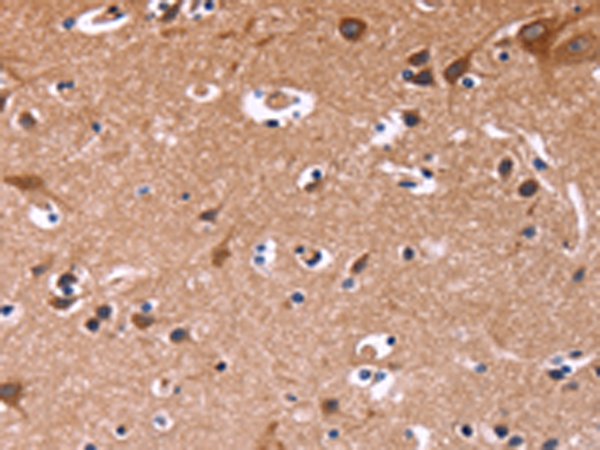

| WB | 咨询技术 | Human,Mouse,Rat |
| IF | 咨询技术 | Human,Mouse,Rat |
| IHC | 1/25-1/100 | Human,Mouse,Rat |
| ICC | 技术咨询 | Human,Mouse,Rat |
| FCM | 咨询技术 | Human,Mouse,Rat |
| Elisa | 1/1000-1/2000 | Human,Mouse,Rat |
| Aliases | CD170; OBBP2; CD33L2; OB-BP2; SIGLEC-5 |
| Host/Isotype | Rabbit IgG |
| Antibody Type | Primary antibody |
| Storage | Store at 4°C short term. Aliquot and store at -20°C long term. Avoid freeze/thaw cycles. |
| Species Reactivity | Human |
| Immunogen | Fusion protein of human SIGLEC5 |
| Formulation | Purified antibody in PBS with 0.05% sodium azide and 50% glycerol. |
+ +
以下是关于SIGLEC5抗体的3篇参考文献示例(注:内容为模拟概括,具体文献请以实际检索为准):
1. **文献名称**:*Targeting SIGLEC5 with a monoclonal antibody enhances phagocytosis and reduces tumor growth in leukemia models*
**作者**:Chen et al.
**摘要**:研究报道了一种靶向SIGLEC5的单克隆抗体,通过阻断其与唾液酸化配体的结合,解除对巨噬细胞的抑制,增强对白血病细胞的吞噬作用,并在小鼠模型中显著抑制肿瘤进展。
2. **文献名称**:*SIGLEC5 as a novel immune checkpoint in myeloid cells: Anti-SIGLEC5 antibody reverses immunosuppression*
**作者**:Angata et al.
**摘要**:作者提出SIGLEC5是髓系细胞(如单核细胞和树突状细胞)的免疫检查点分子,开发的人源化抗体可阻断其信号,恢复T细胞活性,为实体瘤治疗提供新策略。
3. **文献名称**:*Anti-SIGLEC5 antibodies modulate B cell receptor signaling and autoantibody production*
**作者**:Blixt et al.
**摘要**:研究发现SIGLEC5在B细胞中负调控BCR信号通路,使用特异性抗体干预后,可减少自身抗体产生,为自身免疫性疾病(如类风湿性关节炎)提供潜在治疗方向。
如需具体文献,建议通过PubMed或Google Scholar以关键词“SIGLEC5 antibody”或“anti-SIGLEC5”检索近年研究。
SIGLEC5 (sialic acid-binding immunoglobulin-type lectin 5) is a transmembrane protein belonging to the Siglec family of immune-regulatory receptors, primarily expressed on myeloid cells like macrophages, neutrophils, and dendritic cells. It recognizes sialic acid-containing glycans on cell surfaces, mediating cell-cell interactions and modulating immune responses. Structurally, SIGLEC5 contains an N-terminal V-set immunoglobulin domain responsible for ligand binding, followed by C2-set domains, a transmembrane region, and a cytoplasmic tail with immunoreceptor tyrosine-based inhibitory motifs (ITIMs). These motifs recruit phosphatases like SHP-1/2 to dampen signaling pathways, positioning SIGLEC5 as a checkpoint inhibitor in innate immunity.
SIGLEC5 antibodies are tools for studying its role in immune tolerance, inflammation, and disease. Dysregulation of SIGLEC5 is linked to cancers, autoimmune disorders, and infections, as tumor cells often exploit its immunosuppressive function to evade immune surveillance. Antibodies targeting SIGLEC5 can block its inhibitory signaling, potentially enhancing anti-tumor immunity. Conversely, agonist antibodies may suppress excessive inflammation in autoimmune contexts. Recent research also explores SIGLEC5's involvement in neurodegenerative diseases, where aberrant sialylation patterns are observed. Therapeutic antibodies, including bispecific formats or antibody-drug conjugates, are under investigation to modulate SIGLEC5 activity, highlighting its dual role as a biomarker and therapeutic target in diverse pathologies.
×